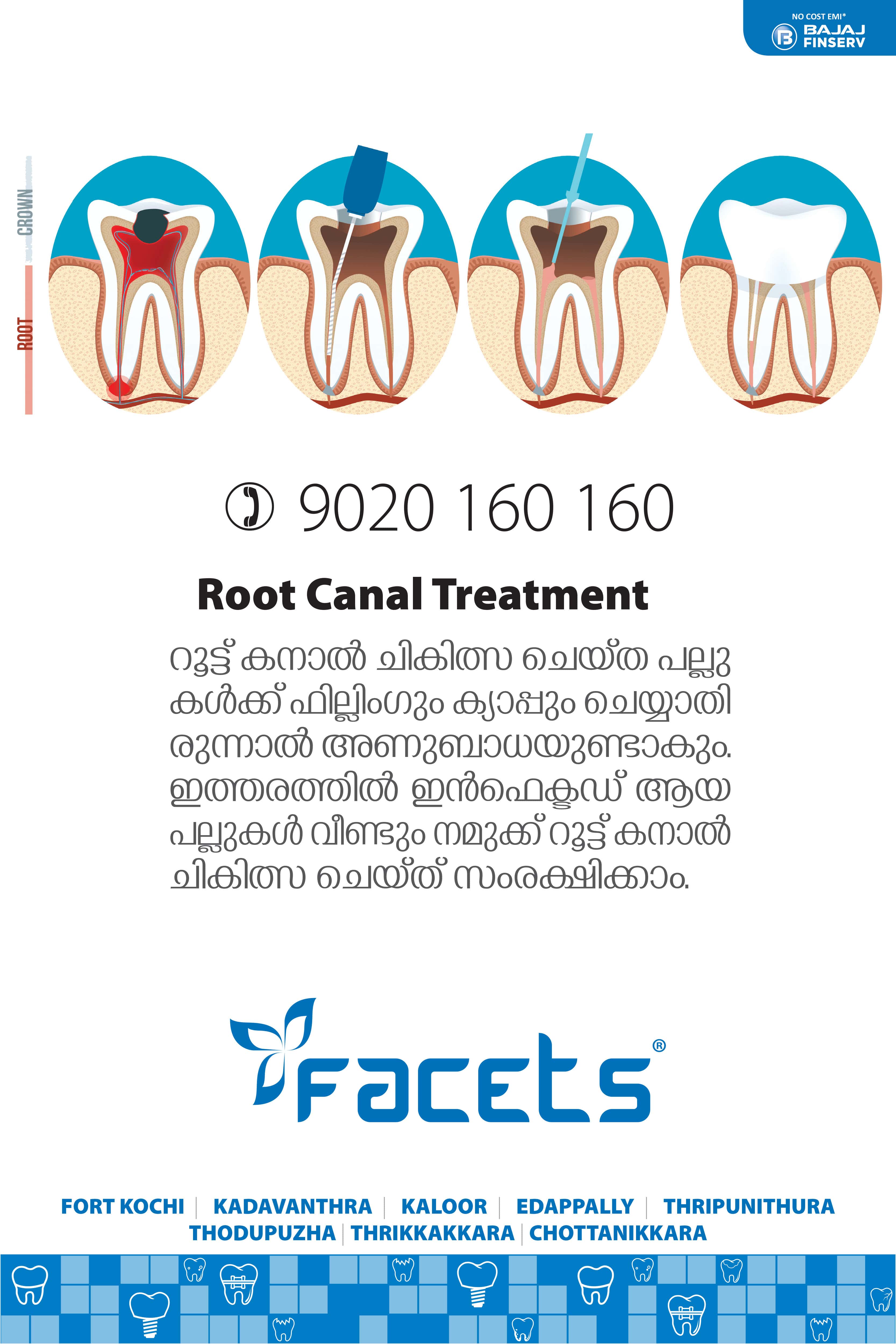
എന്താണ് ഈ ചികിത്സ ?
വേദന വന്ന പല്ലുകളെ , ഒടിഞ്ഞ പല്ലുകളെ , ഇളകുന്ന പല്ലുകളെ ഉപയോഗയോഗ്യമായി വായിൽ നിലനിർത്തുന്നതിനുള്ള ചികിത്സാ വിധി.
എങ്ങനെയാണ് ഈ ചികിത്സ ചെയ്യുന്നത്?
വേദനക്കു കാരണമാകുന്ന പല്ലിന്റെ അണുബാധയേറ്റ ഉൾക്കാമ്പ് നീക്കം ചെയ്ത് അടച്ചു സംരക്ഷിക്കുന്ന ചികിത്സയാണ്.
ചികിത്സാ ഘട്ടങ്ങൾ
ആദ്യ ഘട്ടം
1. രോഗ നിർണ്ണയം. X-Ray വേണ്ടി വരാം.
2. ചികിത്സയെ പറ്റി രോഗിയെ അറിയിക്കുന്നു.
3. ആവശ്യമായ ചർച്ചകൾക്ക്ശേഷം രോഗിയുടെ സമ്മതപത്രം വാങ്ങുന്നു.
4.പല്ലിനെ മരവിപ്പിക്കുന്നു.
5. ആവശ്യപ്പെടുന്നവർക്ക് റബർ ഡാം സംരക്ഷണം നല്കുന്നു
6. പല്ലിൽ ദ്വാരം സൃഷ്ടിച്ച് അതിലൂെടെ ചെറിയ ഉപകരണങ്ങൾ ഉപയോഗിച്ച് ഉൾക്കാമ്പിനെ പുറത്തെടുക്കുന്നു.
7.റൂട്ട് കനാൽ മരുന്നും ലേപനങ്ങളും ഉപയോഗിച്ച് വൃത്തിയാക്കുന്നു.
8. കനാലുകൾ 'ഗട്ടപർച' ഉപയോഗിച്ച് അടക്കുന്നു.
9. ആന്റിബയോട്ടിക് ആവശ്യമായി വന്നേക്കാം.
10. പല്ലിനെ താത്കാലികമായി അടക്കുന്നു.
രണ്ടാം ഘട്ടം
വേദനകളും അസ്വസ്ഥതകളും കുറയുന്നതോടെ ആവശ്യമെങ്കിൽ ഫെബർ പോസ്റ്റ് വച്ച് ബലപ്പെടുത്തി ദീർഘകാലത്തേക്കുള്ള ഫില്ലിംഗ് നല്കി ക്രൗൺ അഥവാ ക്യാപ്പ് ഇട്ട് സംരക്ഷിക്കുന്നു.
ഈ ചികിത്സക്ക് പകരം എന്ത്?
1. ചികിത്സ ചെയ്യാതിരിക്കാം- വേദന സഹിക്കണം
2. മരുന്നു മാത്രം കഴിക്കാം - പാർശ്വഫലങ്ങൾ സഹിക്കണം.
3. പല്ല് നീക്കംചെയ്യുക
ചികിത്സ വിജയം!
വ്യക്തിപരമായ ശാരീരിക അവസ്ഥകൾക്കനുസരിച്ചും
പല്ലിന്റെ ഘടനാപരമായ വ്യത്യാസങ്ങൾക്കനുസരിച്ചും ചികിത്സാ വിജയ ശതമാനത്തിൽ മാറ്റം വരും.
പഠനങ്ങൾ പ്രകാരം 98% ചികിത്സകളും ദീർഘകാല വിജയം നല്കുന്നു.
ചികിത്സയുമായി ബന്ധപ്പെട്ട സങ്കീർണ്ണതകൾ!
സാധാരണയായി നീർവീക്കം, വേദന, വായ്തുറക്കാൻ ബുദ്ധിമുട്ട്, വായിലെ അൾസർ , മരവിപ്പ്, രക്തസ്രാവം എന്നിവ കണ്ടുവരുന്നു.
ചിലപ്പോഴെല്ലാം താഴെ പറയുന്നവയും
1. പല്ലിനെ മരവിപ്പിക്കുന്നതുമായി ബന്ധപ്പെട്ട പ്രശ്നങ്ങൾ
2. പല്ലിന്റെ ഉൾക്കാമ്പിലേക്ക് ഘടനാപരമായ കാരണങ്ങളാൽ എത്താൻ സാധിക്കാത്ത അവസ്ഥ.
3. വേരുകളുടെ എണ്ണക്കൂടുതലുകളും ഘടന പരമായ സങ്കീർണ്ണതകളും.
4. ഉപകരണങ്ങൾ വേരിനകത്ത് വച്ച് ഒടിഞ്ഞ് മുറുകുന്ന അവസ്ഥ.
5. പല്ലിൽ വിള്ളൽ വീഴുക അല്ലെങ്കിൽ തുളകൾ വീഴുക
6.ചികിത്സ ഉപകരണങ്ങൾ വിഴുങ്ങുക
7. മരുന്നുകളോടും ലേപനങ്ങളോടുമുള്ള അല്ലർജികൾ
8. മരുന്നു കഴിക്കുന്നതുമായ ബന്ധപ്പെട്ട പ്രശ്നങ്ങൾ
9. വീണ്ടും അണുബാധയും വേദനയും
10. വേരുകൾ സൈനസിലേക്ക് തുറന്ന അവസ്ഥ
വേദന മാറാത്ത അവസ്ഥയിൽ CBCT സ്കാൻ ചെയ്യേണ്ടതായി വന്നേക്കാം. മൈക്രോസ്കോപ്പിന്റെ ഉപയോഗം സൂക്ഷ്മ ചികിത്സക്ക് സഹായിക്കും.
അടിസ്ഥാന ചെലവ്
1.രോഗനിർണ്ണയം
2. X-ray 2 എണ്ണം
3. റൂട്ട് കനാൽ ചികിൽസ
4. താൽക്കാലിക ഫില്ലിംഗ്
കോവിഡ് ബഡ്ജറ്റ് തുക-2000 മാത്രം.
നിങ്ങൾക്ക് തിരെഞ്ഞെടുക്കാവുന്ന മറ്റു ചെലവുകൾ
1. X-ray- 300 രൂപ
2. റബർ ഡാം - 2000 രൂപ
3. മൈക്രോസ്കോപ്പ് - 4000 രൂപ
4. ലേസർ - 2000 രൂപ
5. പോസ്റ്റ് & കോർ ഫില്ലിംഗ് -3000 രൂപ.
6. പാരാ കോർ ഫില്ലിംഗ് 2000 രൂപ
7.റെസിൻ ഫില്ലിംഗ് - 1500 രൂപ
8.GIC ഫില്ലിംഗ് -500 രൂപ
ചികിത്സാ ഗ്യാരണ്ടി :
ചികിത്സക്ക് ഗ്യാരണ്ടി േചാദിക്കുന്നതും വാഗ്ദാനം ചെയ്യുന്നതും നിയമപരമല്ല.
Endodontic therapy: Endodontic therapy is a procedure to retain a tooth that may otherwise require extraction. it results in the removal of the pulp tissue (nerves and blood vessels) from the inside of the tooth then seals the space with a filling material. Endodontic therapy enjoys a high degree of success, but because it is a biologic procedure, success cannot be guaranteed or warranted. Occasionally, a tooth, which has had endodontic treatment may require retreatment, periradicular surgery or even extraction.
Causes:
a traumatic injury to the tooth
an extensive preparation (drilling) of the tooth. The extensivepreparation may have been done to prepare the tooth for a crown (cap) or other large preparation for a restoration.
The pulp may or may not abscess immediately in these cases. It may take years for a problem to develop. The infected pulp tissue may or may not be painful. It may or may not be visible on a dental
radiograph. A tooth with this type of an abscess is not usually extracted because the infection can be
treated with endodontic therapy on the tooth. This routine procedure can save the tooth and enable you to avoid the harmful effects of tooth loss.
It is successful in more than 90% of the teeth in which the treatment is completed.
Endodontic treatment can take from one to three appointments to complete. Teeth can have one to four canals that need to be treated.
An opening is created to access the nerve, and the abscessed nerve is removed from the root or roots. The canals where the nerves had been located are then cleaned and shaped and a medication may be placed in the canal to promote better healing. When it has been determined that the canals are free of infection, they are filled with a special rubber-like material and sealed with a cementing medium. The abscessed area associated with the tooth will then begin to heal.. Once the endodontic therapy has been completed, the tooth is usually restored with a cast crown or onlay. This is done to protect the tooth and prevent it from fracturing.
Please note that this infection may cause discomfort between root canal appointments. This is normal and usually not a cause for any concern. Contact the office if there is pain and/or swelling. Remember to avoid biting down on the tooth until the root canal is completed and the final restoration has been placed. You may have had no discomfort from the tooth prior to the root canal treatment or have been unaware that you even had an abscess. However, you may experience pain or swelling after the root canal treatment has begun.
If we have prescribed antibiotics for the abscess, be sure to fill the prescription and take it until it is finished. It is important that you do this in order to quickly control the infection. If you do not take the prescribed medication, the resolution of the abscess may be delayed and problems with the postoperative pain are more likely.
Complications of endodontic therapy and anesthesia
may include swelling, pain, trismus (restricted jaw opening), infection, bleeding, sinus involvement and numbness of the lip, gum or tongue, which rarely is protracted and even more rarely permanent.
